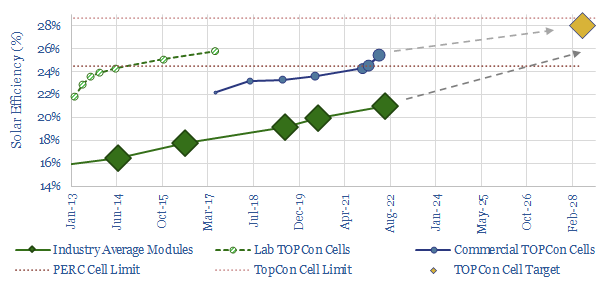A new solar cell is vying to re-shape the PV industry, with 2-5% efficiency gains and c25-35% lower silicon use than today’s PERC cells. This 12-page note reviews TOPCon solar cells, which will take some sting out of solar re-inflation, tighten silver bottlenecks and may further entrench China’s solar giants.
This report starts with our best attempt to condense everything you need to know about the science of solar cells, PV-junctions, and solar efficiency losses into a ‘single page’ on page 2.
PERCs are the incumbents, comprising 80-90% of all solar produced in 2020-21. PERC stands for Passivated Emitter Rear Contact. Page 3 explains what this means and where the remaining bottlenecks are on this design.
TOPCon cells are now taking off, yielding new ‘world records’ on solar cell efficiencies, seemingly every month, in 2022. We have aggregated some of these announcements, commercial deployments and scale-up announcements, from companies such as Longi, Trina, Jinko, Jolywood on page 4. We explain TOPCons on page 5, including the innovations that enable these world-record efficiency levels.
What does it mean for future solar efficiency and why does this matter for ultimate solar costs? Our views on solar cost inflation, materials usage and ultimate price trajectories are spelled out on pages 6-9.
What bottlenecks? TOPCons will most likely use at least 50% more silver per solar cell than PERCs. Thus the bottleneck in PV silicon will be softened, but the bottleneck in silver may be heightened. Who benefits? (page 10).
China’s dominance of the PV solar industry is also likely to be entrenched in the short-term by the rise of TOPCon cells. Although we see a door opening for re-shoring in the longer term. Our overview of energy transition re-shoring is linked here.
Which companies? We think greater deployment of TOPCon cells will be an industry-wide trend, possibly even a stampede. However, leaders so far are profiled on pages 11-12, including a Western private pure-play that may help to accelerate future efficiency gains.
